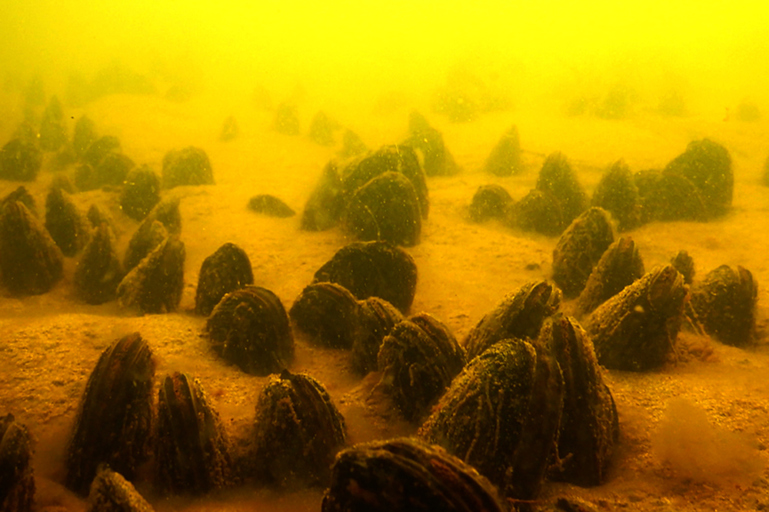Story
‘At risk’ kākahi thriving in Rotokawau

Close-up of Kākahi on the lake bed. (Photo: Ebrahim (Ebi) Hussain - Submerged Environmental)
Dune lakes are one of the rarest and most threatened aquatic habitats in the world and Te Taitokerau is home to more than 400 of them. Their waters are inhabited by a host of extraordinary native plants and animals, some of which are found nowhere else on Earth.
Dune lakes are found within old sand dune systems and are grouped on the Aupōuri, Karikari and Poutō Peninsulas, as well as the Kai Iwi group northwest of Dargaville.
One of the lakes on the Poutō Peninsula is Rotokawau, nestled within pastoral grassland and up to 13m deep. Underneath its serene surface, there’s a wealth of biodiversity to be found.
To help protect and preserve these unique ecosystems, Northland Regional Council regularly checks the health of Te Taitokerau’s dune lakes with diving, water sampling and land-based surveys that assess water quality and ecological conditions. The most recent dive survey at Rotokawau was carried out from 27 February to 2 March 2023.
Divers searched for kākahi (Echyridella menziesii), or freshwater mussels – a native species classified as “At Risk – Declining” – to determine whether the population is reproducing. They found a dense population of adults, as well as some juveniles.
Kākahi (also known as torewai or kāeo), are intriguing creatures, sometimes overlooked alongside their more famous counterpart, the green-lipped marine mussel. They are a taonga species to Māori and for generations have sustained communities as both a food source and a vital element within Aotearoa’s freshwater ecosystems.
Far from being modest molluscs, kākahi have several surprising qualities that elevate them to mighty mussels. Unlike marine mussels that attach themselves to rocks, kākahi have a strong foot that they can use to “walk” about the lakebed, burrow into sediment and anchor themselves with. It’s possible to see the tracks of their wanderings on the lake floor if you know where to look.
Their extraordinary life cycle is dependent on native fish, as for part of their life they are fish parasites. Female kākahi keep their microscopic eggs in a gill pouch, where they are fertilised by a male and then develop into larvae. The female releases the larvae when a fish swims nearby. The larvae hook themselves onto the fish’s gills and fins where they grow into tiny juveniles then detach from their host. This part of their life cycle is still mysterious, but it’s thought the tiny juveniles drift down through the water and live below the sediment surface until they reach adulthood. At about four years of age, they are mature and able to reproduce. Their average life span is 12-30 years, but these fantastic creatures can live as long as 50 or 60 years.
Kākahi are a hugely important bioindicator of water cleanliness and quality, because they require clean water and a healthy environment to thrive. In clean water, one kākahi can filter approximately 1.5L per hour, whereas in turbid water, such as a lake with an algal bloom, filtering capacity drops to about 0.25L per hour per mussel. Finding such a dense colony in Rotokawau is a very positive indicator for the overall health of the lake as the kākahi can filter the lake water, reducing nutrient concentrations and chlorophyll a (which can contribute to algal blooms).
Brooke Gray, Biodiversity Advisor for the council says it’s impressive to find such a dense population of kākahi in one lake.
“Rotokawau is one of the top ecologically outstanding lakes in Northland and we want to keep it that way. Understanding how the kākahi population is doing in this lake is an important step in maintaining this lake’s health.”
“That these kākahi are flourishing demonstrates the positive impact that conservation and biosecurity efforts can have on preserving and maintaining Northland’s unique ecosystems like our dune lakes and their special inhabitants.”



